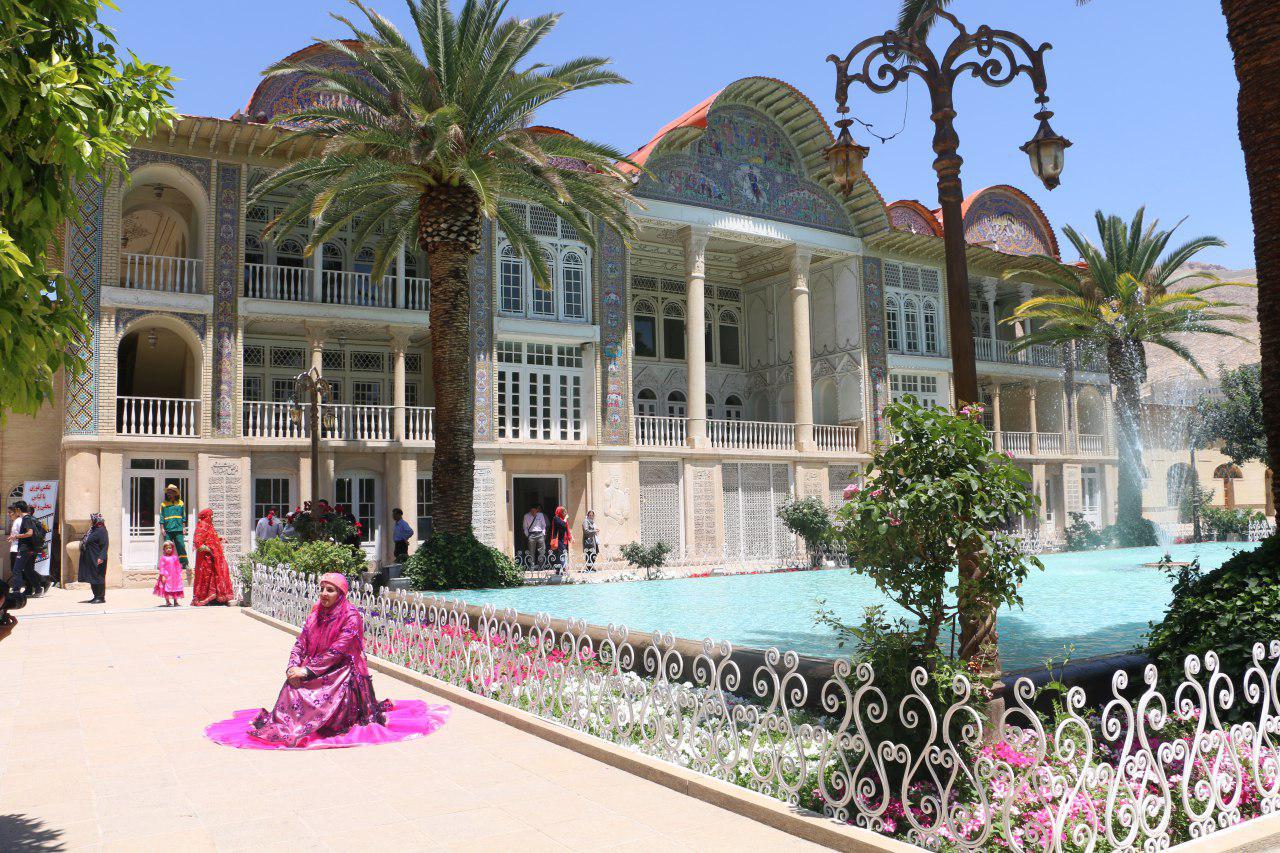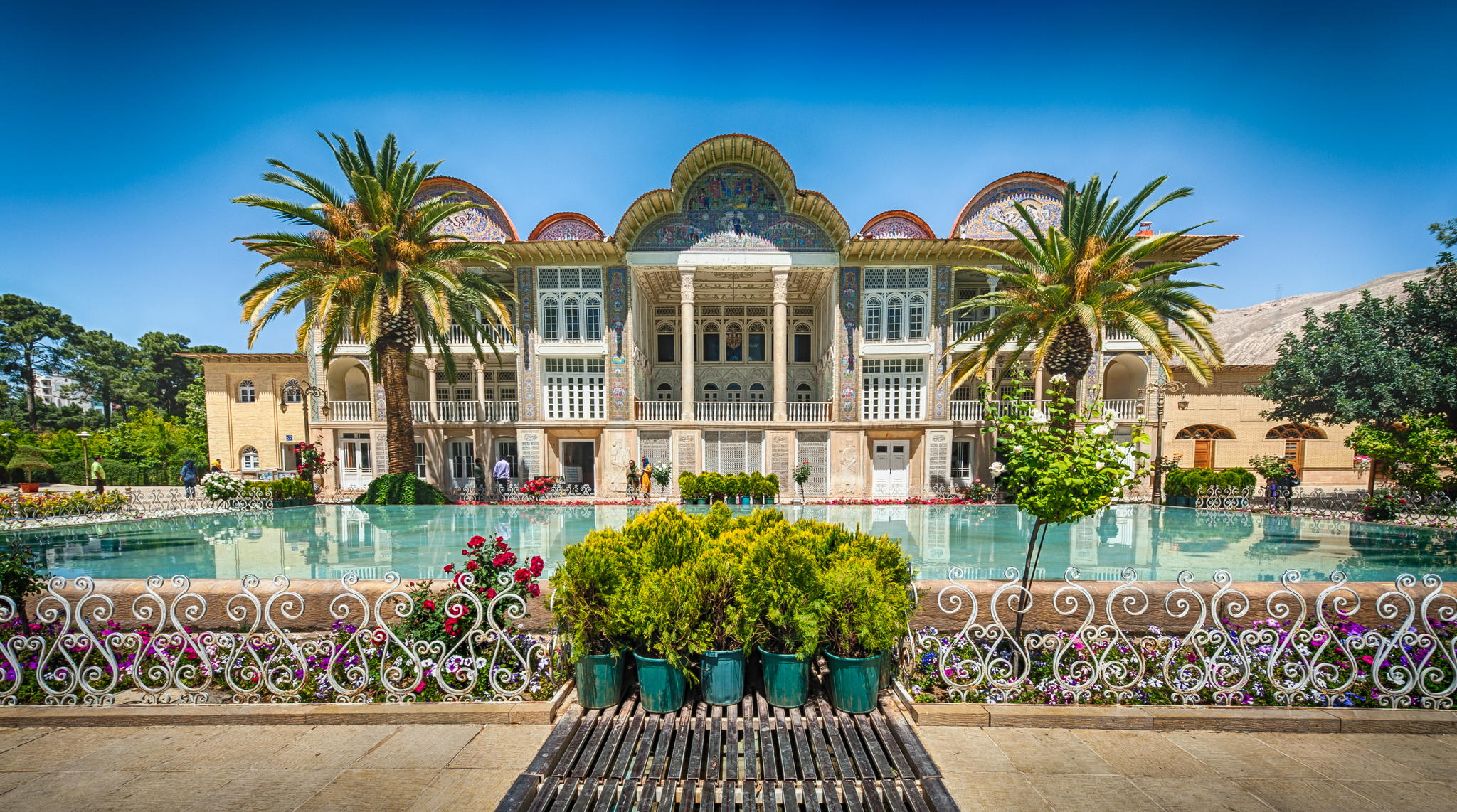Eram Garden

The word ‘Eram’ is the Persian version of the Arabic word ‘Iram’, which means heaven in Islam’s holy book, the Qur’an. The abundance of beautiful flowers, refreshing air, aromatic myrtles, and towering cypress trees, including a tree dating back to 3,000 years (Sarv-e Naz) have made Eram Garden a major tourist destination, especially during the spring and summer.
Eram Garden is one of the most beautiful attractions of Iran and not only Shiraz. Its green and relaxing space can be attracted to any traveler. This beautiful Persian garden is located on Eram Street in Shiraz and many of the best restaurants and cafes in this city are also placed on this street. After a walk for less than 10 minutes, you can see the Azadi Park which is one of the largest and most beautiful parks of Shiraz. On the other side, Eram Garden reaches the new part of Quran gate where the entrance gate and street of Shiraz are located and Tombstone of Khaju-ye Kermani who is one of the famous poets of Shiraz, is also placed here. This part of the city of Shiraz is another attraction of the city with its gorgeous lights at night.
Away from traffic is the beautiful Eram Garden (Bagh-e Eram), a garden named after one of the four gardens of Paradise described in the Quran. It is said that the governor of Shiraz visited the Louvre Museum in Paris and accordingly ordered the hike in the entry price. Even though this garden is lovely, it is small and, of course, has no world-renowned antiquities on display, unlike the Louvre.

It was created by a chief of the Qashqai clan around 1823, with a house later rebuilt by Hali Mohammed Hasan Mi’mar with reception rooms, an orangery, stables, and pavilion. Both garden and buildings were confiscated in 1953 and given to the late shah for his private use; this was when the original mud-brick enclosing walls were torn down and replaced by fencing. Later, the university was permitted to establish a botanical garden.
After the fall Of the Pahlavi regime it was returned to the Qashqai family, but then given back to the university, and today it houses the Law Faculty. Sections of the lower garden are out of bounds, and water rarely runs in the irrigation channels, but it is still a lovely place. Most plants and trees are labeled with Farsi, Latin, and common English names.
If you are keen on roses, they are in the formal gardens behind the main building. Entry into the building itself is not permitted, but the exterior is photogenic enough with its late- 19th-century tiling under the roof.
The main panel shows the legendary Sassanid king, Khosrau, coming across the Armenian princess Shirin bathing while to the right is the Quranic/biblical story describing how the beauty of the Prophet Yusuf (Joseph) caused the ladies in Pharaoh’s court to cut their fingers while peeling fruit. Above, the meeting of King Soleyman (Solomon) and the Queen of Sheba, Bilqis, is depicted.

There are three other major gardens in Shiraz but two are 20th-century constructions, owing little to the classic Persian garden layout but pleasant enough now the price for foreigners has been lowered. The decoration of the pavilion was completed by Hassan Ali Khan’s son Abol Qassem Khan who inherited the garden after his father. The garden finally went to Abol Qassem Khan’s son Abdullah Qavami who sold it to Qashqai tribes once again. The beautiful three-story pavilion of the garden was constructed based on Safavid and Qajar style of architecture.
The lower story of the mansion has an impluvium especially designed for relaxation during the hot days of summer. The ceiling of this structure is beautifully adorned with colorful tiles. A small stream also passes through it, connecting to a large pool in front of the building. The middle story has a large veranda erected on two pillars behind which stands a magnificent hall. On the two sides of the hall, there are two corridors each having 4 rooms and two small terraces. The front sides of the pillars are decorated with tiles showing the images of horsemen and flowers.
The upper story consists of a large hall whose windows open to the main veranda. It is also surrounded by two corridors leading to two terraces. On the entablature of the building, there are three arched (semi-circular, crescentic) pediments ornamented with tile work.
The middle pediment, being larger than the other two, shows Nasser ed-din Shah (a famous Qajar king) on the back of a white horse. Around this picture, some scenes based on stories from the works of Ferdowsi and Nezami (two famous poets) can be seen. One of the small pediments represents an image of Darius the Great (the founder of the Achaemenid Dynasty) as represented in Persepolis monuments.

And finally, the third pediment illustrates a deer being hunted by a panther. The garden with its beautiful flowers, refreshing air, tall cypresses (a stately, beautiful cypress tree there known as Sarv-e Naz which is said to go back to 3000 years ago) and fragrant myrtles is a major tourist destination, especially in the spring.
The lower sections of the exterior of the building are formed of 2 – meter – high plain and carved stones and on the eight columns there is the exhibit of two Qajar soldiers and six inscriptions. The inscriptions have been inscribed by Mirza Ali Naghi Khoshnevis in Nastaligh style of writing. In the portal of the building, there are three large and two small sessions.
The spring, which flows in the waterfronts, right in the middle of the building pours into ponds and grants Eram garden a great appeal. The cypress tree in this garden is quite famous.
Tags:botanical garden, Eram Garden, Ferdowsi, major gardens, major gardens in Shiraz, Nezami, Persepolis, poets, Qajar, Qashqai, Shiraz, The Persian Garden
